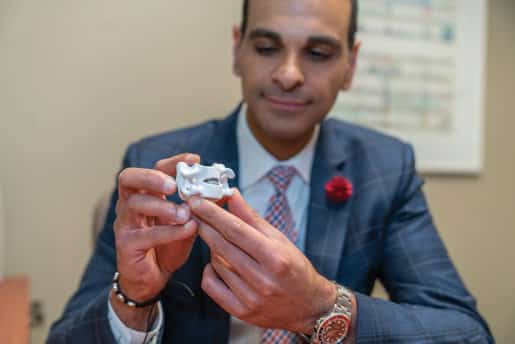Cervical disc arthroplasty a better option than spinal fusion for many patients
By Bob Bong
Above photo: Dr. Mark Mikhael and his patient, Ann Sciortino.
Cervical disc arthroplasty is a relatively new surgical procedure in which degenerated or herniated discs in the cervical spine (the neck) are replaced with artificial devices. The procedure is used to treat severe, chronic pain resulting from degenerative disc disease or disc herniation.
The procedure, which takes an hour or less, is a less-invasive alternative to spinal fusion surgery, says Mark Mikhael, MD, an orthopedic surgeon at Illinois Bone & Joint Institute (IBJI).
Spinal fusion, which can limit a patient’s mobility, requires removing the affected discs and grafting the cervical vertebrae together to stabilize the spine. It can put pressure on the remaining vertebrae, which can lead to similar disc problems in the future. Studies have shown that cervical disc arthroplasty, however, has higher patient success rates and lower rates of complications and reoperations.
Perpetual pain
Wilmette resident Ann Sciortino, 50, says cervical disc arthroplasty has been life-changing. For years, she endured crippling pain caused by a degenerative disc and a pinched nerve in her neck. Pain radiated down her arm, and sleeping was almost impossible. “I would toss and turn all night,” she recalls. “I couldn’t find a spot that was not painful. I felt like a rotisserie chicken spinning all night.”
Sciortino tried physical therapy and cervical epidural steroid injections, but they provided limited relief. “Dr. Mikhael and my pain management doctor said
I was a good candidate for the arthroplasty procedure,” she says. Three weeks after surgery, she was cleared to resume her regular activities. “It was the best thing I ever did. I’m incredibly grateful,” she says.
Rapid recovery
Cervical disc arthroplasty requires a small incision to be made in the front of the neck. The affected discs are removed and replaced with artificial disc devices, which are sized for the patient to ensure a proper fit.

The advanced medical technology of arthroplasty lessens the effects of surgery, reduces recovery time and contributes to fewer follow-up visits and subsequent procedures.
“The replacement disc allows the bone to retain its natural range of motion for rotating the neck and looking up and down,” Mikhael says. “The patient is upright right away, there’s no need for a neck brace or collar, no limitations on movement.”
“There’s less physical therapy and less surveillance X-rays to make sure the bones are healing. Shorter stays are less costly. And patients are back to their normal activities faster,” he explains.
Patients with advanced arthritis, distorted anatomy, neck fractures or traumatic injuries are not good candidates for cervical disc arthroplasty, Mikhael cautions. But for the right patients, especially younger individuals, he says,
“It gives patients their life back.”
And now? “I’m literally pain free,” Sciortino says. “I feel like I did 20 years ago. I’m learning to play tennis, and I’m back kayaking. I’m pretty active again.”
To find a location and learn more about Illinois Bone & Joint Institute, visit ibji.com











